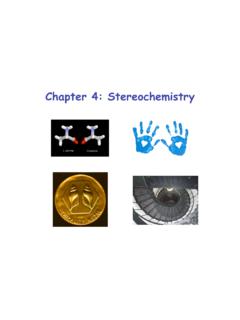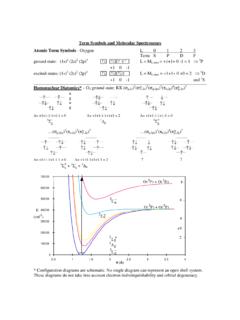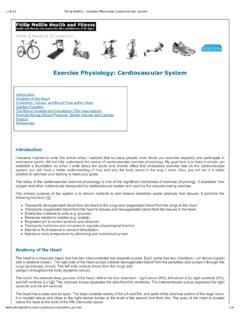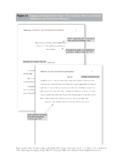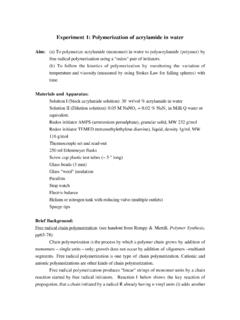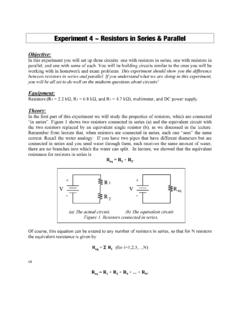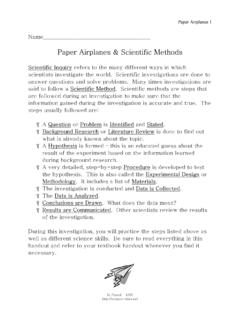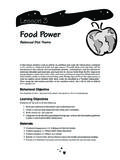Transcription of Experiment 1 Chemical Equilibria and Le Châtelier’s Principle
1 Experiment 1 Chemical Equilibria and Le Ch telier s Principle A local theatre company is interested in preparing solutions that look like blood for their upcoming production of Lizzie Borden. They have hired Chemical Solutions Incorporated (CSI), to help them investigate the aqueous reaction of potassium thiocyanate with iron(III) nitrate that they have heard other companies are using as fake blood. You will investigate this equilibrium for CSI both qualitatively and quantitatively. The following useful information for these experiments is excerpted from reliable Web sites, and is reproduced with permission of the authors. You should also prepare for this Experiment by reading about Chemical Equilibria and Le Ch telier s Principle (Chapter 15 in your textbook). The Iron-Thiocyanate Equilibrium When potassium thiocyanate [KNCS] is mixed with iron(III) nitrate [Fe(NO3)3] in solution, an equilibrium mixture of Fe+3, NCS , and the complex ion FeNCS+2 is formed (equation 1).
2 The solution also contains the spectator ions K+ and NO3 . The relative amounts of the ions participating in the reaction can be judged from the solution color, since in neutral to slightly acidic solutions, Fe+3 is light yellow, NCS is colorless, and FeNCS+2 is red. If the solution is initially reddish, and the equilibrium shifts to the right (more FeNCS+2), the solution becomes darker red, while if the equilibrium shifts to the left (less FeNCS+2), the solution becomes lighter red or straw yellow. You will add various reagents to this reaction at equilibrium to see if/how those reagents shift the equilibrium position of the reaction using the color of the resulting solution. Fe+3 + NCS FeNCS+2 (1) yellow colorless blood red Quantitatively, the relative amounts of the two reactants and the product are related by the equilibrium constant for the reaction; in this case, the formation constant Kf, which is shown below.
3 To precisely control the red color of the solution, it is necessary to know the value for Kf. Kf can be calculated through an experimental determination of the [FeNCS+2]eq using a standard curve (week 2) and deduction of the [Fe+3]eq and [NCS ]eq by subtracting the amount of FeNCS+2 produced from the known added initial amounts of Fe+3 and NCS (as that is how much was consumed during the reaction). [FeNCS+2]eq [Fe+3]eq[NCS ]eq Use of a Standard Curve In this technique a series of solutions with known concentrations is prepared and then a parameter such as absorbance is measured. This parameter is then plotted versus concentration to yield a standard curve (in this case how absorbance varies with concentration), which is often a straight line with some degree of experimental error. Analysis of the data allows determination of the best-fit line ( , with Excel).
4 A subsequent measurement of the absorbance for an unknown sample allows determination of its concentration using the equation for the standard curve. The unknown concentration should lie in the concentration range of the standard solutions used to construct the standard curve for an accurate concentration determination. Beer s Law Beer s Law relates the experimental absorbance value for a chromophore (a substance that absorbs light) to the concentration of that chromophore in solution. Beer's law has many forms, the most common is: A = l C. In this equation A is the measured absorbance of the chromophore at a given wavelength (usually at a peak maximum, or lmax, determined from a spectrum spanning ultraviolet and/or visible wavelengths of light). The Greek letter epsilon, , stands for the molar extinction coefficient (M 1cm-1), an experimentally determined constant for the specific chromophore at a specified wavelength.
5 The molar extinction coefficient is a quantitative measure of the light absorbance by the chromophore at that wavelength for a one molar solution and a one-centimeter path length. The value l is the path CH 142- Experiment 1- Spring 2012 2 length, or the distance the light travels through the solution in the cuvette (container) used for the absorbance measurement. Lastly, C is the molar concentration of the chromophore (mol/L) used for the measurement. Beer's law says that the relationship between the absorbance of the chromophore and its concentration is linear, allowing construction of a standard curve by plotting absorbance versus concentration, such as shown in Figure 1. This particular curve is most reliable for absorbance values between The concentration for an unknown solution can be determined by measuring its absorbance first.
6 Then use the known absorbance value and the equation for the standard curve to solve for x, the concentration. Figure 1. Absorbance vs. concentration (M) of a chromophore. CH 142- Experiment 1- Spring 2012 3 Pre-Laboratory Assignment Week 1: Buy your lab notebook (see Lab Syllabus for specific requirements). This week (and every week), come to lab with a hand written outline of the experimental procedure in your lab notebook. Week 2: In addition to the usual outline of the procedure in your lab notebook, please answer the following questions.
7 Due before 9 AM, Fri., Feb. 10th (in white bookcase by Keyes 310). A. Calculate the concentrations of NCS- and Fe+3 in each of the following solutions. Note that the final total volume is mL in each case due to the addition of H2O. As always, all work must be shown to receive full credit. Watch those units and sig figs. volume M KNCS (mL) volume M Fe(NO3)3 (mL) total solution volume (mL) B. 1. Construct a standard curve in Excel using the following data (and micromolar concentration gives absorbance) based on the absorbance at 275 nm of protein sample. Print your graph once it is titled (Y vs X), includes the equation of the line and the R2 value, has a label for each axis and includes any appropriate units. 2. Use this graph to determine the unknown concentrations of two samples of the protein, showing your work. 3. Would you expect these determinations to be accurate or not?
8 Explain your answer. Concentration of Protein Sample Absorbance at 275 nm micromolar micromolar micromolar micromolar unknown concentration 1 unknown concentration 2 CH 142- Experiment 1- Spring 2012 4 Experimental Procedure- Week 1, Feb. 6th-10th For each of the external stresses described below, necessary information is provided regarding the manner in which one or more of the Chemical species is affected. You will use a spot plate containing multiple wells and use a different well for each of the operations described, recording your observations of the color change of the solution. In the Data section of your lab book, create a detailed table summarizing your observations for each of the reactions that you ll perform (see below) on the iron-thiocyanate equilibrium. As an example, if you added a drop of concentrated HCl to the standard solution, the blood-red color would lighten or perhaps even disappear altogether.
9 This indicates that the FeNCS+2 concentration has decreased. To explain this result, it is necessary to know that in the presence of a large excess of Cl-, Fe+3 forms complex ions: Fe+3 + 6 Cl- FeCl6-3 This change reduces the Fe+3 concentration, so in accord with Le Chatelier s Principle , some FeNCS+2 dissociates to replace some of the Fe+3 removed by reaction with Cl-. This would be summarized in your lab book as follows: A. Operations to Introduce an External Stress- Record all observations in your data table. 1. Add one drop each of 1 M Fe(NO3)3 and 1 M KNCS to 25 mL of distilled water. Mix well. 2. Add a few drops of this solution to each of seven wells of a spot plate. One well will serve as a color standard against which to judge color changes in the other wells. The other six wells will be for performing your operations to introduce an external stress.
10 Record the appearance of the reaction before adding stress. 3. Add one drop of 1 M Fe(NO3)3 to one of the wells, mix, and observe. Record observation. 4. Add one drop of 1 M KNCS to a second well, mix, and record observation. 5. Add one drop of SnCl2 to a third well, mix, and record observation. Tin(II) ions reduce iron(III) ions to iron(II) ions: Sn+2 + 2 Fe+3 Sn+4 + 2 Fe+2 6. Add one drop of M AgNO3 to a fourth well, mix, and record observation. Silver ions react with thiocyanate ions to give a white precipitate of silver thiocyanate: Ag+ + NCS- AgNCS(s) 7. Add one drop of M Na2 HPO4 to a fifth well, mix, and record observation. Hydrogen phosphate ions form a complex ion with iron(III) ions: Fe+3 + HPO4-2 FeHPO4+ Stress Observation Reactions of Interest Explanation +1 drop HCl (6 M) soln turned yellow (the original red color went away) Fe+3 + NCS FeNCS+2 Fe+3 + 6 Cl FeCl6 3 Equilibrium shifted left in response to a decrease in [Fe+3], which was removed by its reaction with Cl.
